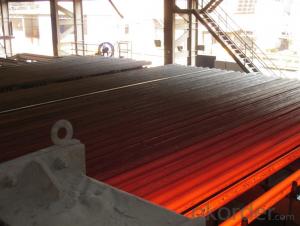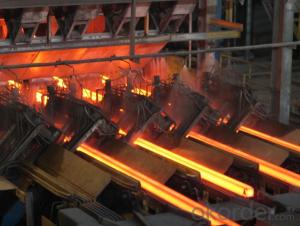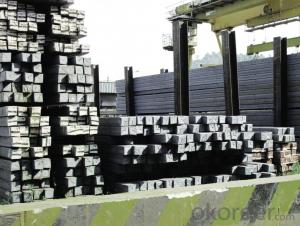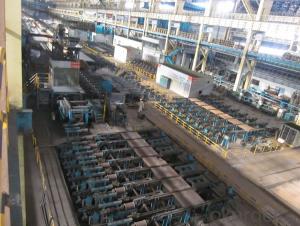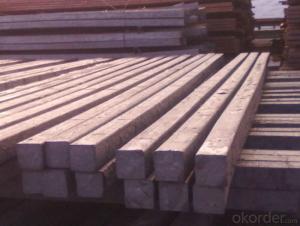Prime Q275 85mm Square Alloy Steel Billet
- Loading Port:
- Shanghai
- Payment Terms:
- TT OR LC
- Min Order Qty:
- 100 m.t.
- Supply Capability:
- 10000 m.t./month
OKorder Service Pledge
OKorder Financial Service
You Might Also Like
Structure of Prime Q275 85mm Square Alloy Steel Billet

Description of Prime Q275 85mm Square Alloy Steel Billet
1. Prepainted steel coil is coated with organic layer, which provides higher anti-corrosion property and a longer lifespan than that of galvanized or galvalume steel sheets.
2. The base metals for prepainted steel coil consist of cold rolled, HDGI Steel, electro-galvanized and hot-dip alu-zinc coated steel. The finish coats of prepainted steel coil can be classified into groups as follows: polyester, silicon modified polyesters, polyvinylidene fluoride, high-durability polyester, etc.
3. The production process has evolved from one-coating-and-one-baking to double-coating-and-double-baking, and even three-coating-and-three-baking.
4. The color of the prepainted steel coil has a very wide selection, like orange, cream-colored, dark sky blue, sea blue, bright red, brick red, ivory white, porcelain blue, etc.
5. The prepainted steel coils can also be classified into groups by their surface textures, namely regular prepainted sheets, embossed sheets and printed sheets.

Main Feature of Prime Q275 85mm Square Alloy Steel Billet
Uncoated CR steel sheet
With the features of in line with the international highest standards in demension and shape, excellent surface finish and properties, the products are mainly used in home appliance and automobile industries.
Galvanized steel sheet(include HDG and EG)
With the features of good corrosion resistance, the products are mainly used in automobile, home appliance, electronics, building and machinery manufacture industries, etc.
Precoated steel sheet
With the features of enviromental protection and good processablility, long lasting surface durability, rich in colors, the products are maily used in building, home appliance and furniture industries, etc.
Applications of Prime Q275 80mm Square Alloy Steel Billet
A. Corrugated design makes it excellent waterproof performance
B. Materials as prepainted steel sheets, galvanized steel sheets, galvalume (Al-Zn coated sheets) are available to make corrugated sheet.
C.Those material are durable, anti-corrosion in bad weather for 20-30 years based on it's Zinc(Galvanized) coating or AZ (Galvalume) coating.
D. Different shape of the sheet make it suitable for any style of buildings.
E.Easy to install, no need special tools to fix the sheet.
F.Light weight due to high strength to weight ratio of steel. Light weight means easier handling lower shipping costs, easier installation
G. Different color is availbe base on the RAL Standard make your building more beautiful.
H. We will provide the best solutions if you don't have a exact idea of the specification you want for the steel sheet based on your weather conditions, engineering structure, construction budget and so on.

Specifications of Prime Q275 85mm Square Alloy Steel Billet
Product | Billet |
Material Grade | SGCC / SGCH / DX51D+AZ, etc |
Thickness | 0.6-3.0mm |
Width | 500-1500mm |
Tolerance | Thickness: +/-0.02mm , Width:+/-2mm |
Zinc-coating | Z30-150g/m2 |
Technique | Raw material: Hot rolled steel coil --> Cold rolled_>hot dipped galvalume |
Surface | Dried, Chromated, Unoiled |
Spangle | Regular spangle , small spangle, zero spangle |
ID | 508MM 610MM |
Coil weight | 1-25MT |
Export package | Cardboard inner sleeves, Waterproof paper, galvanized steel covered and steel strip packed |
FAQ of Prime Q275 85mm Square Alloy Steel Billet
We have organized several common questions for our clients,may help you sincerely:
1. How Can I Visit There?
Our company is located in Tianjin City, China, near Beijing. You can fly to Tianjin Airport Directly. All our clients, from home or aboard, are warmly welcome to visit us!
2. How Can I Get Some Sample?
We are honored to offer you sample.
3. Why choose CNBM?
Our delivery time about 15-20days for standard sizes, if you have other requirements like hardness, quanity and width ,it is about 20-40days. But don't worry we also try our best for the delivery time ,because time longer and our cost is higher.
- Q:What are the different types of steel billet machining processes?
- There are several types of steel billet machining processes, including turning, milling, drilling, and grinding. Each of these processes involves different techniques and tools to shape and refine the steel billet into the desired form or component.
- Q:What are the different types of cutting machines used for steel billets?
- Steel billets can be cut using different types of cutting machines, each designed to ensure efficient and precise cuts for desired dimensions and quality. 1. Bandsaw machines, widely utilized for cutting steel billets, employ a continuous loop of toothed metal blade guided around wheels. The billet is fed into the machine, and the blade cuts through it with high precision. 2. Circular saw machines, equipped with circular metal blades with teeth, are commonly used to cut large billets into smaller pieces. These machines can be operated manually or automatically, depending on the specific application. 3. Waterjet cutting machines employ a high-pressure stream of water mixed with abrasive materials to accurately cut through steel billets of varying thicknesses and shapes. This method is known for its versatility. 4. Plasma cutting machines utilize a plasma torch to cut steel billets. An electric arc generated by the torch passes through a small nozzle, releasing ionized gas. The heat from the arc melts the metal, while the gas blows away the molten material, resulting in a precise cut. 5. Laser cutting machines employ a high-powered laser beam to melt or vaporize steel billets, creating precise cuts with high speed and accuracy. 6. Shearing machines are commonly used to cut steel billets into specific lengths or shapes. These machines apply a shearing force using a blade or a pair of blades, making them suitable for high-volume production settings. The choice of cutting machine depends on factors such as desired cut quality, speed, and specific requirements of the steel billet cutting process, as each machine has its own advantages and limitations.
- Q:Charcoal classification
- Hard charcoal. By hardwood such as Fagaceae Quercus, Castanopsis trees, secondary birch and etc..Broad-leaved charcoal. Charcoal made from a mixture of hard and soft hardwood.Pine charcoal. Carbon fired from pine or other needle wood. In addition to bamboo and bamboo charcoal burning with shells, stones (coconut shell, peach stone charcoal etc.) wood raw material firing. Charcoal collected from household stoves in the cell known as carbon. If the charcoal is crushed and mixed with proper adhesive, and then pressed, formed and roasted, the deposit is made. According to the burning process of silica and carbon black.
- Q:What is the role of steel billets in the manufacturing of railway wheels?
- Steel billets are the starting material used in the manufacturing of railway wheels. They are heated and forged into the desired shape and dimensions, forming the solid base for the wheels. The billets undergo various processes such as rolling, machining, and heat treatment to ensure the wheels have the necessary strength, durability, and dimensional accuracy required for railway applications.
- Q:What are the main factors affecting the quality of steel billets?
- The main factors affecting the quality of steel billets include the composition of the raw materials used, the temperature and duration of the heating process, the cooling rate, and the presence of impurities or defects in the final product. Additionally, the quality of the equipment and machinery used during the production process, as well as the expertise and experience of the workers, can also significantly impact the quality of steel billets.
- Q:What are the different surface treatments for corrosion resistance in steel billets?
- Steel billets can be enhanced for corrosion resistance through various surface treatments. These treatments play a crucial role in preventing rust and oxidation, which can greatly degrade the quality and lifespan of the billets. Some commonly used surface treatments for corrosion resistance in steel billets are as follows: 1. Hot-dip galvanizing: By immersing the steel billets in molten zinc, a protective coating is formed on the surface. This zinc coating acts as a sacrificial layer, safeguarding the steel against corrosion. 2. Electroplating: Through an electrochemical process, a thin layer of a corrosion-resistant metal like nickel or chromium is deposited onto the surface of the steel billet. This plated metal serves as a barrier, preventing direct contact between the steel and corrosive agents. 3. Passivation: This treatment involves the use of chemicals, usually an acid solution, to eliminate impurities or contaminants that may encourage corrosion. Passivation results in the formation of a passive oxide layer on the surface, which provides corrosion resistance. 4. Powder coating: In this method, a dry powder is electrostatically applied to the surface of the steel billet and then heat-cured. The powder melts and forms a protective layer on the steel, offering excellent corrosion resistance. 5. Organic coatings: These coatings, such as paints or varnishes, are applied to the surface of the steel billet. They create a protective barrier against moisture and corrosive agents. Organic coatings can be customized based on specific requirements in terms of color, texture, and durability. 6. Anodizing: Primarily used for aluminum or aluminum alloy steel billets, this treatment involves subjecting the surface to an electrochemical process, resulting in the formation of an oxide layer. This anodized layer enhances corrosion resistance while also providing an aesthetic appearance. Choosing the appropriate surface treatment for steel billets is crucial, considering factors like the intended application, environmental conditions, and expected lifespan. Regular maintenance and periodic reapplication of the surface treatment may also be necessary to ensure sustained corrosion resistance.
- Q:Can steel billets be forged into complex shapes?
- Yes, steel billets can be forged into complex shapes. The forging process involves heating the steel billet to a specific temperature, typically above its recrystallization temperature, and then applying pressure to shape it into the desired form. This can be done using various forging techniques such as open die forging, closed die forging, or impression die forging. Steel is a highly malleable material, which means it can be easily shaped and deformed under heat and pressure. This property allows steel billets to be forged into intricate and complex shapes, including gears, turbine blades, automotive parts, and many other components used in various industries. The forging process not only shapes the steel billet but also improves its mechanical properties, making it stronger and more durable. Additionally, the forged steel has a refined grain structure, which enhances its toughness and resistance to fatigue and cracking. However, forging complex shapes from steel billets requires skilled craftsmanship and specialized equipment. The process may involve multiple steps, including pre-forming, rough forging, and finish forging, to achieve the desired shape and dimensions. Computer-aided design (CAD) and computer-aided manufacturing (CAM) technologies are often used to optimize the forging process and ensure accurate and precise results. In conclusion, steel billets can indeed be forged into complex shapes. The forging process harnesses the malleability of steel and transforms it into intricate components with improved mechanical properties.
- Q:How are steel billets used in the production of shipbuilding components?
- Steel billets are essential in the production of shipbuilding components as they serve as the primary raw material. Shipbuilding components require a high level of strength, durability, and corrosion resistance, all of which can be achieved through the use of steel billets. Firstly, steel billets are heated and then passed through a series of rolling processes to produce various shapes and sizes of steel plates, beams, and bars. These components are crucial in the construction of the ship's hull, superstructure, and other structural components. For example, steel plates are used to form the ship's outer shell, while beams and bars are utilized to provide support and stability. Furthermore, steel billets can be forged or machined to create specialized shipbuilding components such as propeller shafts, rudder stocks, and engine mounts. These components play vital roles in the ship's propulsion system, steering mechanism, and overall functionality. Additionally, steel billets can be used to manufacture pipes and tubes that are crucial for the ship's plumbing, ventilation, and fuel systems. The use of steel billets in shipbuilding ensures the vessels are built to withstand the harsh marine environment, including extreme weather conditions and corrosive seawater. Steel is known for its high strength-to-weight ratio, making it an ideal choice for constructing large and sturdy ships. Moreover, steel is easily weldable, allowing for efficient assembly and fabrication processes during ship construction. Overall, steel billets are a fundamental component in shipbuilding, providing the necessary strength, durability, and corrosion resistance required for the construction of various ship components. From the hull and superstructure to specialized parts, steel billets are indispensable in the production of shipbuilding components.
- Q:Can steel billets be used for making sculptures?
- Yes, steel billets can be used for making sculptures. Steel is a versatile material that offers various benefits for sculpting. Its strength and durability make it suitable for creating large-scale sculptures that can withstand outdoor conditions. Steel billets can be easily manipulated and shaped into different forms, allowing artists to explore their creativity and bring their ideas to life. Additionally, steel can be welded, polished, and painted, providing further opportunities for customization and artistic expression. Overall, steel billets offer sculptors a robust and versatile medium to create unique and lasting sculptures.
- Q:What are the main factors that influence the strength of steel billets?
- The main factors that influence the strength of steel billets include the chemical composition of the steel, the heat treatment process, the presence of impurities and alloying elements, the cooling rate during the solidification process, and the mechanical processing and deformation of the billets.
1. Manufacturer Overview |
|
|---|---|
| Location | |
| Year Established | |
| Annual Output Value | |
| Main Markets | |
| Company Certifications | |
2. Manufacturer Certificates |
|
|---|---|
| a) Certification Name | |
| Range | |
| Reference | |
| Validity Period | |
3. Manufacturer Capability |
|
|---|---|
| a)Trade Capacity | |
| Nearest Port | |
| Export Percentage | |
| No.of Employees in Trade Department | |
| Language Spoken: | |
| b)Factory Information | |
| Factory Size: | |
| No. of Production Lines | |
| Contract Manufacturing | |
| Product Price Range | |
Send your message to us
Prime Q275 85mm Square Alloy Steel Billet
- Loading Port:
- Shanghai
- Payment Terms:
- TT OR LC
- Min Order Qty:
- 100 m.t.
- Supply Capability:
- 10000 m.t./month
OKorder Service Pledge
OKorder Financial Service
Similar products
New products
Hot products
Hot Searches
Related keywords
